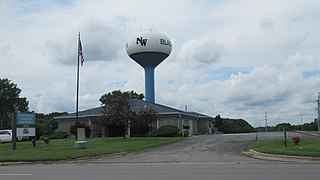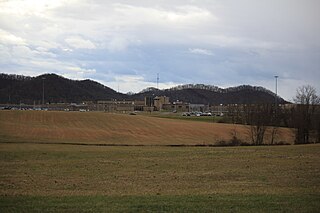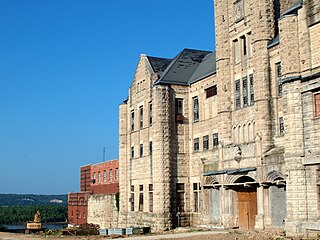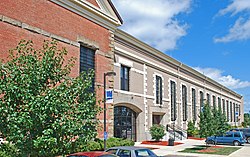
Jackson is the only city in, and seat of government of, Jackson County in the U.S. state of Michigan. As of the 2020 census, the city population was 31,309. Located along Interstate 94 and U.S. Route 127, it is approximately 40 miles (64 km) west of Ann Arbor and 35 miles (56 km) south of Lansing. Jackson is the core city of the Jackson Metropolitan Statistical Area, which includes all of Jackson County and has a population of 160,248.

Blackman Charter Township is a charter township of Jackson County in the U.S. state of Michigan. As of the 2020 census, the township population was 25,642.
Auburn Correctional Facility is a state prison on State Street in Auburn, New York, United States. It was built on land that was once a Cayuga village. It is classified as a maximum security facility.
Pontiac Correctional Center, established in June 1871, is an Illinois Department of Corrections maximum security prison for adult males in Pontiac, Illinois. The prison also has a medium security unit that houses medium to minimum security inmates and is classified as Level 3. Until the 2011 abolition of the death penalty in Illinois, the prison housed male death row inmates, but had no execution chamber. Inmates were executed at the Tamms Correctional Center. Although the capacity of the prison is 2172, it has an average daily population of approximately 2000 inmates.

William C. Holman Correctional Facility is an Alabama Department of Corrections prison located in Atmore, Alabama. The facility is along Alabama State Highway 21, 9 miles (14 km) north of Atmore in southern Alabama.

Oregon State Penitentiary (OSP), also known as Oregon State Prison, is a maximum security prison in the northwest United States in Salem, Oregon. Originally opened in Portland 173 years ago in 1851, it relocated to Salem fifteen years later. The 2,242-capacity prison is the oldest in the state; the all-male facility is operated by the Oregon Department of Corrections (ODOC). OSP contains an intensive management wing, which is being transformed into a psychiatric facility for mentally ill prisoners throughout Oregon.

The Penitentiary of New Mexico (PNM) is a men's maximum-security prison located in unincorporated Santa Fe County, 15 miles (24 km) south of central Santa Fe, on New Mexico State Road 14. It is operated by the New Mexico Corrections Department.

The Southern Ohio Correctional Facility is a maximum security prison located just outside Lucasville in Scioto County, Ohio. The prison was constructed in 1972. As of 2023, the warden is Cindy Davis.

Menard Correctional Center, known prior to 1970 as Southern Illinois Penitentiary, is an Illinois state prison located in the town of Chester in Randolph County, Illinois. It houses maximum-security and high-medium-security adult males. The average daily population as of 2007 was 3,410.
Great Meadow Correctional Facility is a maximum security prison in New York State in the United States. The prison is in Comstock, a hamlet right outside of the village of Fort Ann in Washington County, New York. As of September 3, 2008 it was home to 1,663 inmates. When Great Meadow opened in 1911 it was the fourth prison for adult males constructed in the state of New York.
The Pendleton Correctional Facility, formerly known as the Indiana Reformatory, is a state prison located in Fall Creek Township, Madison County, near Pendleton and about 25 miles (40 km) northeast of Indianapolis. Established in 1923, it was built to replace the Indiana State Reformatory located in Jeffersonville after a fire severely damaged the original property. The Pendleton facility currently offers maximum and minimum-security housing for adult males over 22 years old. The maximum-security portion is made up of 31 acres (130,000 m2) surrounded by a concrete wall. It has an average daily population of approximately 1,650 inmates. Located on the grounds outside the enclosure, the minimum-security dormitory holds approximately 200 prisoners on a daily basis.
The Oklahoma State Reformatory is a medium-security facility with some maximum and minimum-security housing for adult male inmates. Located off of State Highway 9 in Granite, Oklahoma, the 10-acre (4.0 ha) facility has a maximum capacity of 1042 inmates. The medium-security area accommodates 799 prisoners, minimum-security area houses roughly 200, and the maximum-security area with about 43 inmates. The prison currently houses approximately 975 prisoners. The prison was established by an act of the legislature in 1909 and constructed through prison labor, housing its first inmate in 1910. The facility is well known for the significant roles women played in its foundation and governance, most notably having the first female warden administer an all-male prison in the nation.

The Ohio Penitentiary, also known as the Ohio State Penitentiary, was a prison operated from 1834 to 1984 in downtown Columbus, Ohio, in what is now known as the Arena District. The state had built a small prison in Columbus in 1813, but as the state's population grew the earlier facility was not able to handle the number of prisoners sent to it by the courts. When the penitentiary first opened in 1834, not all of the buildings were completed. The prison housed 5,235 prisoners at its peak in 1955. Prison conditions were described as "primitive" and the facility was eventually replaced by the Southern Ohio Correctional Facility, a maximum security facility in Lucasville. During its operation, it housed several well-known inmates, including General John H. Morgan, George "Bugs" Moran, O. Henry, Chester Himes, and Sam Sheppard. A separate women's prison was built within its walls in 1837. The buildings were demolished in 1997.

California State Prison, Sacramento (SAC) is a male-only state prison located in the city of Folsom, in Sacramento County, California. The facility is also referenced as Sacramento State Prison, CSP-Sacramento, CSP-SAC, and occasionally, New Folsom or New Folsom Prison which was its official name prior to October 1992.

The Marquette Branch Prison (MBP) is located in Marquette, Michigan on the south shore of Lake Superior. The prison, which opened in 1889, is a facility of the Michigan Department of Corrections that holds about 1,100 inmates in maximum and minimum-security housing. The inmate population consists of adult males, aged eighteen and older. The prison was listed on the National Register of Historic Places as State House of Correction and Branch Prison on November 23, 1977.

The Montana State Prison is a men's correctional facility of the Montana Department of Corrections in unincorporated Powell County, Montana, about 3.5 miles (5.6 km) west of Deer Lodge. The current facility was constructed between 1974 and 1979 in response to the continued degeneration of the original facility located in downtown Deer Lodge.

The Missouri State Penitentiary was a prison in Jefferson City, Missouri, that operated from 1836 to 2004. Part of the Missouri Department of Corrections, it served as the state of Missouri's primary maximum security institution. Before it closed, it was the oldest operating penal facility west of the Mississippi River. It was replaced by the Jefferson City Correctional Center, which opened on September 15, 2004.
The Parnall Correctional Facility is a state prison for men located in Jackson, Jackson County, Michigan, owned and operated by the Michigan Department of Corrections.
The G. Robert Cotton Correctional Facility is a state prison for men located in Jackson, Jackson County, Michigan, owned and operated by the Michigan Department of Corrections.
The Charles Egeler Reception and Guidance Center (RGC) is a state prison for men located in Jackson, Jackson County, Michigan, owned and operated by the Michigan Department of Corrections.




















